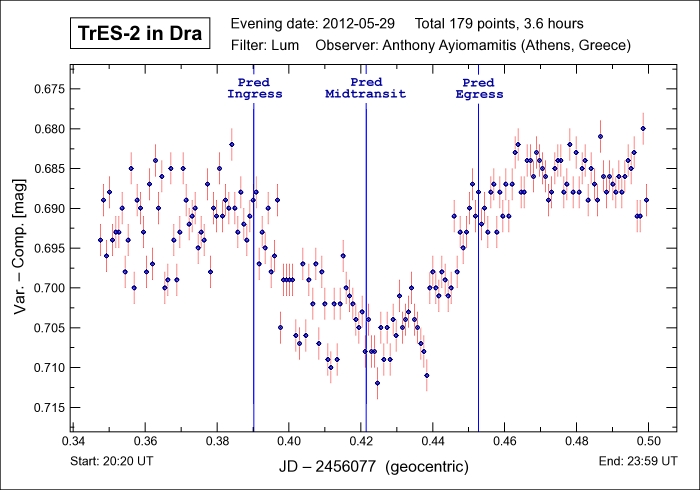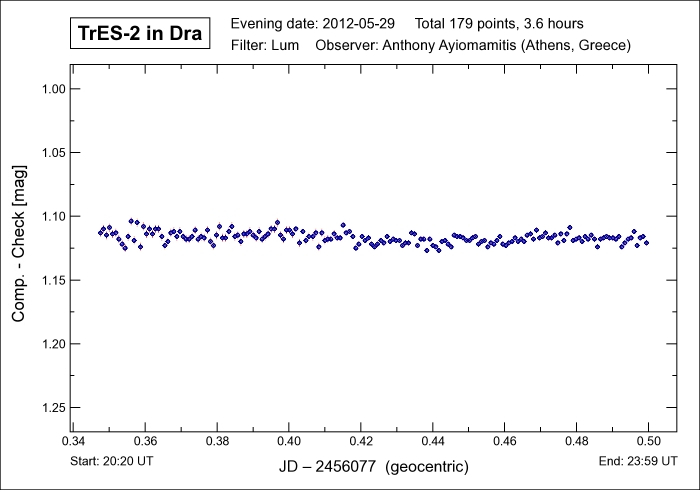
A variable star, as its name suggests, is a star whose magnitude varies intrinsically, in contrast to eclipsing binaries whose magnitude
varies as a result of one star in the binary system eclipsing the other. True variables are one of five types, namely Mira stars, semiregular
stars, cepheids, eruptive variables and, finally, cataclysmic variables. Minimum to maximum magnitude can range from days to many months with
some variables displaying irregular periods.
A popular method for the study of variable stars, particularly short-term variables, is by the use of the technique known as "differential
photometry". Rather than measure the (variable) magnitude of a variable star on an absolute scale, measurements are made over time relative
to one or more non-variable star(s) and these differences are then plotted so as to study and illustrate the relative or differential change
in magnitude. Due to the very large number of variables stars, the field of differential photometry represents one of the key fields in
astronomy whereby the amateur astronomer can make a meaningful and long-lasting contribution to both science and astronomy.
More recently, the search for extrasolar planets (over 700 discovered so far) has identified yet another interesting application for the
practice of differential photometry whereby the minute drops in magnitude of a star hosting an exoplanet are studied. Further details for the
interested party are available here.
Note: The light curve for exoplanet TrES-2b in Draco depicted below is one of the latest transitting exoplanets,
having being discovered in mid-2006 and which represents the second discovery of the Trans-Atlantic Exoplanet Survey team. It is characterized
with a mass and radius slightly greater than that of Jupiter and a brief orbital period of only 60 hours. TrES-2b requires 90.0 minutes to
transit its parent star at a depth of 1.69%. The parent star, GSC 3549:2811, is estimated to have a mass of 1.08 solar masses, a radius
equivalent to 1.00 solar radii and a temperature of 5,960° K. Although the light curve is generally "V-shaped", indicative of a grazing
transit, it is believed that TrES2-b does not graze its parent star. However, the brief transit period of 90 minutes does suggest a
near-grazing exoplanet. Furthermore and as suggested by the reference lines below with respect to predicted ingress, midtransit and egress,
the light curve suggests an earlier than expected transit and which has been observed by others, thus suggesting
that an adjustment to the published exoplanet's period may be appropriate. Since exoplanet TrES-2b lies in the Kepler zone, a region of the sky
which is the focus of the current NASA Kepler mission, it is anticipated that over
600 transits of TrES-2b will be studied! Further details regarding TrES-2 and TrES-2b are available in the paper published by the discovery
team led by Francis O'Donovan et al here.
Note: The C- and K-stars used for the purposes of the differential photometry measurements depicted below were
GSC 3549:2716 (mag 10.95) and GSC 3549:2776 (mag 12.1) respectively.
|
Parent Star: TrES-2 GSC/SAO Catalog: GSC 3549:2811 Constellation: Draco RA / Dec: 19h 07m 14s / +49° 18' 59" Magnitude: 11.411 Distance: 718 light-years Exoplanet: TrES-2b Period: 2.47063 + 0.00001 d Transit Duration: 90.0 mins Transit Depth: 16.9 mmag Minimum Mass: 1.28 MJup Radius: 1.24 RJup Pred Transit Details:
|
 
|
Date: May 29-30, 2012 23:20:00 - 02:59:45 UT+3 Location: Athens, Greece Equipment: AP 305/f3.8 Riccardi-Honders AP 1200GTO GEM SBIG ST-10XME SBIG CFW-10 SBIG LRGB filters Integrations:
Temperatures:
Software: CCDSoft V5.00.201 AIP4Win V2.4.0 Processing: Reduction Differential Photometry |